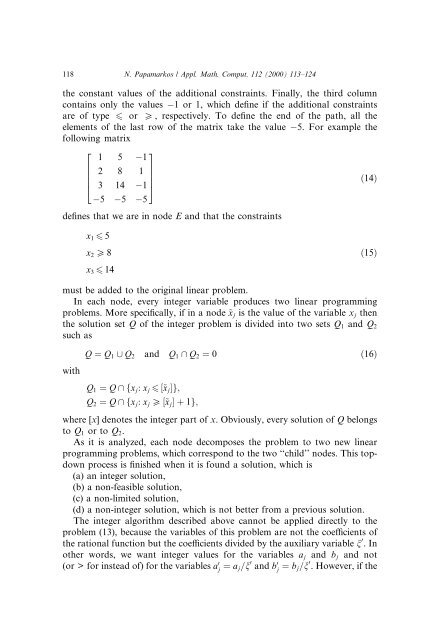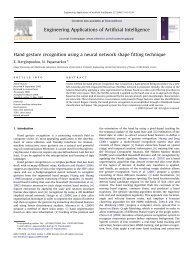On the approximation of real rational functions via mixed-integer ...
On the approximation of real rational functions via mixed-integer ...
On the approximation of real rational functions via mixed-integer ...
Create successful ePaper yourself
Turn your PDF publications into a flip-book with our unique Google optimized e-Paper software.
118 N. Papamarkos / Appl. Math. Comput. 112 (2000) 113±124<strong>the</strong> constant values <strong>of</strong> <strong>the</strong> additional constraints. Finally, <strong>the</strong> third columncontains only <strong>the</strong> values 1 or 1, which de®ne if <strong>the</strong> additional constraintsare <strong>of</strong> type 6 or P , respectively. To de®ne <strong>the</strong> end <strong>of</strong> <strong>the</strong> path, all <strong>the</strong>elements <strong>of</strong> <strong>the</strong> last row <strong>of</strong> <strong>the</strong> matrix take <strong>the</strong> value 5. For example <strong>the</strong>following matrix231 5 12 8 167…14†4 3 14 1 55 5 5de®nes that we are in node E and that <strong>the</strong> constraintsx 1 6 5x 2 P 8x 3 6 14…15†must be added to <strong>the</strong> original linear problem.In each node, every <strong>integer</strong> variable produces two linear programmingproblems. More speci®cally, if in a node ~x j is <strong>the</strong> value <strong>of</strong> <strong>the</strong> variable x j <strong>the</strong>n<strong>the</strong> solution set Q <strong>of</strong> <strong>the</strong> <strong>integer</strong> problem is divided into two sets Q 1 and Q 2such aswithQ ˆ Q 1 [ Q 2 and Q 1 \ Q 2 ˆ 0 …16†Q 1 ˆ Q \fx j : x j 6 ‰~x j Šg;Q 2 ˆ Q \fx j : x j P ‰~x j Š‡1g;where [x] denotes <strong>the</strong> <strong>integer</strong> part <strong>of</strong> x. Obviously, every solution <strong>of</strong> Q belongsto Q 1 or to Q 2 .As it is analyzed, each node decomposes <strong>the</strong> problem to two new linearprogramming problems, which correspond to <strong>the</strong> two ``child'' nodes. This topdownprocess is ®nished when it is found a solution, which is(a) an <strong>integer</strong> solution,(b) a non-feasible solution,(c) a non-limited solution,(d) a non-<strong>integer</strong> solution, which is not better from a previous solution.The <strong>integer</strong> algorithm described above cannot be applied directly to <strong>the</strong>problem (13), because <strong>the</strong> variables <strong>of</strong> this problem are not <strong>the</strong> coecients <strong>of</strong><strong>the</strong> <strong>rational</strong> function but <strong>the</strong> coecients divided by <strong>the</strong> auxiliary variable n 0 .Ino<strong>the</strong>r words, we want <strong>integer</strong> values for <strong>the</strong> variables a j and b j and not(or > for instead <strong>of</strong>) for <strong>the</strong> variables a 0 j ˆ a j=n 0 and b 0 j ˆ b j=n 0 . However, if <strong>the</strong>




